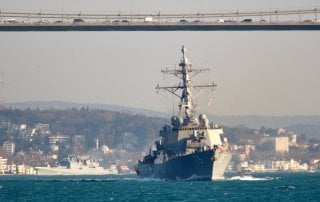The Facts are in on the U.S. Navy's New Constellation-class Frigate
Constellation-Class ships would free up Navy destroyers to undertake anti-surface and anti-air roles by performing duties like convoy escort and anti-submarine warfare in their stead. Still, the Constellation-class would be no slouch if push came to shove.
A new report from the Congressional Research Service, a nonpartisan public policy research institute, provided more details into the Navy's new frigate, the Constellation-class. The report shows how the Navy's ships will differ from their parent design, the Italian-French FREMM (Fregata Europea Multi-Missione) frigate.
Building a new class of warships is not an easy task, nor is it cheap. Take the Navy's Littoral Combat Ships, the Freedom and Independence-classes—those ships' budgets ballooned, triggering a Congressionally-mandated production halt. That's why the U.S. Navy opted to modify an existing design rather than build a from-scratch plan from the ground up.
Frigates
"In contrast to cruisers and destroyers, which are designed to operate in higher-threat areas, frigates are generally intended to operate more in lower-threat areas," the Congressional Research Service report on the Constellation-class explained. "U.S. Navy frigates perform many of the same peacetime and wartime missions as U.S. Navy cruisers and destroyers, but since frigates are intended to do so in lower-threat areas, they are equipped with fewer weapons, less-capable radars and other systems, and less engineering redundancy and survivability than cruisers and destroyers."
One of the primary differences between the Italo-French design and its American counterpart is length: the Constellation-class will be over twenty-three feet longer. The Navy anticipates using the additional space to accommodate larger, more powerful generators and provide future growth flexibility. Likewise, the Constellation-class's total displacement increased by about 500 tons. In addition, the Constellation-class's propellers will be fixed-pitch "for improved acoustic signature."
Constellation-Class ships would free up Navy destroyers to undertake anti-surface and anti-air roles by performing duties like convoy escort and anti-submarine warfare in their stead. Still, the Constellation-class would be no slouch if push came to shove.
The Navy would potentially like to arm the frigates with the Naval Strike Missile, an over-the-horizon weapon, and newer extended range Harpoon anti-ship missiles, significantly augmenting the class's firepower against surface ships.
Postscript
Although the Constellation-class frigates would not be nearly as capable as the Navy's Arleigh Burke-class destroyers, especially in an anti-air role, the class could offer a potent anti-submarine and anti-surface ship capability. In addition, if the Navy chooses to integrate the Naval Strike Missile and extended range Harpoon missile onto the platform, the new frigates could be quite capable. And by modifying an already existing design, the new class is less likely to cause massive budget overruns seen in previous Navy programs.
In total, the Navy would like to procure twenty Constellation-class ships, with the first fifteen hulls expected by 2026.
Caleb Larson is a multimedia journalist and Defense Writer with The National Interest. He lives in Berlin and covers the intersection of conflict, security, and technology, focusing on American foreign policy, European security, and German society.
Image: Reuters

